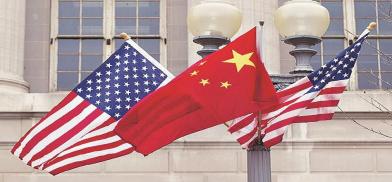Can the US underwrite regional stability against emerging Chinese threats?
In the long run, if tactically implemented, the B3W initiative can also help India and its allies balance China’s String of Pearls strategy in South Asia and beyond, writes Pradeep S. Mehta for South Asia Monitor

The US is getting back its mojo after President Joe Biden’s recent Europe trip. At the G-7 summit in UK’s Cornwall, Biden proudly declared that “America is back at the table”. It will also serve as a warning to the ambitious Chinese Communist Party that things will no longer be the same. This will hugely benefit multilateralism which was given a near burial by Biden’s immediate predecessor Donald Trump’s administration.
A few steps in this direction agreed to at Cornwall include a commitment to providing about 1 billion vaccines to the poorer countries. This will serve some but not the entire humanity. Hope others, such as Russia and India, step in.
In terms of the climate change agenda, they agreed to stop funding new coal-based thermal power plants and make good their old 2009 pledge of jointly mobilizing USD 100 billion per year to assist poor countries to tackle the climate change impact. One hopes this is done rather than lost again in meaningless platitudes.
There was an agreement to dissuade multinational corporations, particularly tech giants, from shifting profits to low-tax havens and pay a minimum of 15 percent corporate tax. Here again, there were a few conditions but one hopes the western powers keep their resolution alive. In the US particularly, one sees hope as the establishment is after the big tech in many ways and is therefore unlikely to back off under pressure.
Lastly, as a response to China’s Belt and Road Initiative (BRI), the G7 summit launched a Build Back Better World (B3W) partnership - a bold and value-driven global infrastructure initiative led by the democratic leaders of the world. Its purpose is to help narrow the USD 40 trillion infrastructure gap faced by the global south.
According to the US, the focus will be on the areas of climate change, health security, gender equity, equality and technology. All are potential areas, but one needs to attack poverty and inequality in the developmentally backward countries more directly than as an outcome of other investments. Mind you the immiseration has worsened after the pandemic.
India’s gains from B3W
For India, the B3W initiative will strengthen its relationship with the democratic West and East, collectively catalyze funds in infrastructure development in the region and, most importantly, keep China wary of manifesting aggression closer to India’s borders, both in the north, with Tibet and Bhutan, and in the south, with Sri Lanka.
In the long run, if tactically implemented, this initiative can also help India and its allies balance China’s String of Pearls strategy in South Asia and beyond that focussed on the construction of infrastructure networks in the littoral nations from the South China Sea to the Middle East.
But the B3W initiative is undefined and vague on specifics. If this has to rival BRI, then the G7 better get its act together and create a single institution or empower the World Bank with a trust fund with at least some leverage capital i.e., USD 500 billion to be credible. It should also lift the good ideas from the two Chinese-floated successful infra-funding institutions: Asian Infrastructure Investment Bank and the New Development Bank.
Otherwise, the poor countries would not mind mortgaging their family silver to get funding and projects from a single source: BRI.
Challenging China's dominance
It is in this context, one needs to understand the Open Societies Statement signed on by the seven plus four invitees including India. It reflects their collective resolve to counter authoritarian regimes in global and regional spheres and stresses the need for open societies to collaborate and challenge China’s dominance in global supply chains and critical arteries, and build safeguards against any global shocks.
Three years ago, China was not even mentioned in the G7 communique, but some of the proposals fleshed out were explicit on the need to counter its rise. Said an American official: “The statement has a section on China that speaks about the importance of coordinating on and responding to China’s non-market economic practices and the need to speak out against human rights abuses, including in Xinjiang and Hong Kong”.
The Chinese Communist Party was not amused. A Chinese official in their London embassy reacted rather sharply: “The days when global decisions were dictated by a small group of countries are long gone”.
Yet all signals on China are music to New Delhi as Indians observed on June 15 the first anniversary of the Galwan Valley clash where 20 of their soldiers died in combat with China’s People’s Liberation Army.
The clash resulted from China’s obduracy to settle the border issues with India peacefully and in tranquility. These soldiers and perhaps more on the Chinese side - a figure China has refused to disclose - died in close combat, where primitive weapons were used following an agreement not to use firepower in any manner whatsoever.
The Indo-Pacific dynamics
Biden’s next stop after Cornwall was Brussels. His stay started with a North Atlantic Treaty Organization (NATO) meeting. Biden wanted to salve the wounds left by Trump on NATO and to say that America will continue to lead the free world. He thus sent out a strong message to the rest of the world.
Biden’s visit included a bilateral meeting with Turkish President Recep Tayyip Erdoğan, but there was no agreement on US opposition to Turkey also buying the Russian S-400 missile defense system, which India is also purchasing.
In his meetings with EU leaders, an important landmark was created. The US and the EU agreed to keep their long-standing dispute on subsidies to aircraft makers Airbus and Boeing on the backburner for five years, and focus instead on reducing China’s increasing dominance in world trade.
In fact, China has been successful in developing passenger aircraft and will soon become a competitor to the Western duopoly. Other than Russia, there are two other small manufacturers in Canada and Brazil but they are much small compared to Airbus or Boeing. The Shanghai-headquartered Commercial Aircraft Corporation of China makes passenger aircraft of capacities ranging from around 70 to 250, which can give a run for money to the duopoly. However, the US has reportedly banned any American company or individual from investing in the Chinese company, because it belongs to the People’s Liberation Army.
Biden’s last meeting was with Vladimir Putin, President of Russia. They did not hug each other, but chatted freely for three hours, noting that “even in periods of tension,” the two nations share goals of “ensuring predictability in the strategic sphere, reducing the risk of armed conflicts and the threat of nuclear war."
This was sort of something better than nothing and Biden wanted to establish a personal relationship with Putin and vice versa. Another step forward was that they agreed to restore ambassadors in each other’s capitals. Most importantly, Biden said that “we are two great powers”, which was not countered by Putin. These words are quite significant and between the lines send a message to China also, that it should not be as ambitious as it is.
This sums up an emerging story. While the US is getting back its mojo of being a power that can underwrite peace, security and stability in a region, the operative word is ‘a’ and not ‘the’. Let it focus its energy on the Indo-Pacific region, including connecting seas on both sides of India - the Bay of Bengal in the east and the Arabian Sea in the west - and work potentially with Russia for ensuring peace and stability in the Middle East and North Africa.
(The writer is Secretary-General, CUTS International, a global public policy think tank. Krithika Subramaniam and Jithin Sabu of CUTS also contributed to the article. The views expressed are personal)









Post a Comment